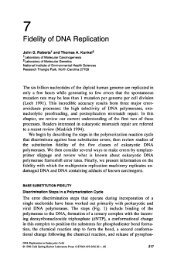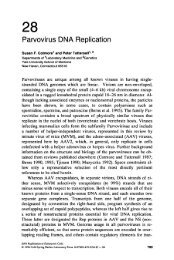Chapter 39: Mitochondrial DNA Replication (PDF)
Chapter 39: Mitochondrial DNA Replication (PDF)
Chapter 39: Mitochondrial DNA Replication (PDF)
Create successful ePaper yourself
Turn your PDF publications into a flip-book with our unique Google optimized e-Paper software.
<strong>Mitochondrial</strong> <strong>DNA</strong> <strong>Replication</strong> 1019<br />
isotopic labeling and electron microscopic visualization approaches<br />
(Clayton 1982). There has been no extensive further work along these<br />
lines, although there have been attempts to utilize isolated organelles as a<br />
way to study various steps of mt<strong>DNA</strong> replication (for examples, see<br />
Dunon-Bluteau et al. 1987; Enriquez et al. 1994). Although this approach<br />
may lead to insights on regulating replication, it has some limitations,<br />
since it is not possible to define the molecules responsible for various<br />
events in the process nor to test easily for the efficacy of altered reaction<br />
conditions, different templates, and requirements for known, purified<br />
entities.<br />
TRANSACTING FACTORS INVOLVED IN REPLICATION<br />
The close physical and functional relationships between leading-strand<br />
mt<strong>DNA</strong> replication and transcription have resulted in data from studies<br />
of each process that merge at the level of transcription initiation from the<br />
strong promoter upstream of OH. Promoter-specific transcription requires<br />
the presence of the transcription factor mtTFA (formerly termed mtTF1)<br />
in addition to a mitochondrial RNA (mtRNA) polymerase fraction that<br />
alone is incapable of selective transcription (Fisher et al. 1987). Mature<br />
human mtTFA (h-mtTFA) is a small (204 amino acids) basic protein that<br />
binds immediately upstream of the mitochondrial promoters. There is an<br />
excellent correlation between <strong>DNA</strong> binding by h-mtTFA and the ability<br />
of that protein to support correct and efficient transcription initiation<br />
(Dairaghi et al. 1995 and references therein), and Fisher et al. (1992)<br />
were able to demonstrate that h-mtTFA has the capacity to unwind and<br />
bend <strong>DNA</strong>, thereby suggesting the manner in which at least one part of<br />
the transcription initiation process takes place.<br />
Human mtTFA contains two domains characteristic of high mobility<br />
group (HMG) proteins, and these two domains (HMG boxes) comprise<br />
most of the molecule. The two HMG boxes are interrupted by a 27-<br />
amino-acid linker sequence, and the protein contains a 25-residue,<br />
carboxy-terminal tail. Mutational analysis of the protein has recently<br />
shown that this short tail is critical for <strong>DNA</strong> binding at the promoter and<br />
for transcriptional activation (Dairaghi et al. 1995).<br />
Processing of <strong>Mitochondrial</strong> Transcripts for <strong>Replication</strong><br />
The first isolated mammalian mtRNA processing activity was ,RNase<br />
MRP (for mitochondria1 RNA processing), which was isolated from<br />
mouse and human mitochondrial fractions and shown to be a site-specific






